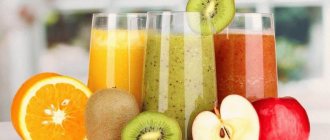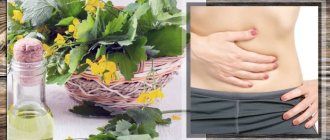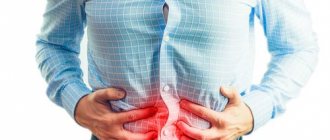Diet for stomach and duodenal ulcers is an obligatory component of complex therapy, which does not lose relevance even at the stage of stable remission. Also, such a diet, in parallel with treatment, is recommended for patients with gastritis and stomach ulcers associated with Helicobacter pylory.
Patients with stomach ulcers are prescribed a special diet - table No. 1. Dietary table No. 1 has 2 modifications: No. 1A and 1B:
- 1A - strict nutrition with limited calories, prescribed in the first 14 days of exacerbation of acute or chronic gastritis, ulcers
- illness, as well as 7 days after gastric surgery (i.e., this diet is also prescribed after a perforated stomach ulcer). Involves the consumption of all dishes in liquid, puree and porridge forms, frequent meals 6-7 times a day. Vegetables and fruits in any form are excluded, as well as bread (even from the list of permitted ones).
- 1B – a gentle diet after completing table 1A with increased calorie content. Dishes are liquid or mushy, meals are 5-6 times a day, vegetables, fruits and bread remain prohibited.
After stabilization, you can slightly diversify the menu from the list of permitted products.
General principles
Based on the principles of therapeutic nutrition, it is possible to adjust the diet and stop the progression of the disease. The basis of the diet is:
- Balanced diet. Diet does not mean fasting: the menu must be balanced, have an energy value of at least 2800-3000 kcal/day: 100 g. protein, 100 gr. fat, 400 gr. carbohydrates.
- Fractional meals. The maximum break between meals is 3 hours.
- The last meal is 2 hours before bedtime. You can drink warm milk before bed.
- Small portion sizes. Approximate volume – palms folded into a handful.
- Dietary preparation methods. Baking, boiling, steaming, blanching.
- Grinding. The priority is crushed, ground foods, which are easier to digest and assimilate.
- The temperature of the dishes is about 30-40 degrees. Hot and cold foods are unacceptable because they inhibit enzyme formation and slow down tissue repair.
- Normalization of drinking regime. Increasing daily consumption of clean water to 1.5 liters.
- Limit salt to 5-10 g. per day, which irritates the gastrointestinal mucosa and retains fluid in the body. Although in many diets it is written that salt can be consumed up to 12 grams. per day, but the less the better.
To reduce the secretion of the digestive glands during the period of remission, carbonate and sulfate mineral waters with a mineralization level of 2-6 g/l are recommended: Borjomi, Essentuki. Consume it without gases, warm, quickly.
Principles:
- Mechanical and chemical sparing: selection of foods eaten at one meal, exclusion of food that activates digestive secretion.
- Zigzag nutrition. Introducing foods from the prohibited list (within reasonable limits) for short periods of time, followed by a return to the diet menu. Used individually only in patients with stable remission, it is a kind of training for the gastrointestinal tract.
- Individuality. Common principles of nutrition are the basis on which to rely, but individual parameters must be taken into account: stage, location of the ulcer, age, body weight of the patient, concomitant diseases.
- Taking into account the time it takes to digest food. Data on the digestion time of each dish can be found online. For example, 1 glass of broth stays in the stomach for about 1.5 hours, meat - about 3 hours, legumes - about 5 hours.
Fried is prohibited, only boiled, baked or stewed.
How long to stick to the diet?
A strict diet for stomach ulcers must be followed during an exacerbation for 2 weeks (see below for more details). At the early stage of recovery, the goal of the diet is to accelerate the recovery of the gastric mucosa, and in the future, to prevent relapse. Next, a gentle diet must be followed for at least one year after the last exacerbation of the disease, but better – for the rest of your life.
This is interesting: Sigmoid colon: location, structure and functions
Is it possible to eat root vegetables if you have a peptic ulcer?
The presence of a large number of useful substances and elements in beets allows us to consider them medicinal.
The root vegetable perfectly stimulates the gastrointestinal tract:
- enhances peristalsis;
- helps in digestion of food;
- normalizes metabolism and microflora;
- takes part in maintaining blood cholesterol levels and reducing the load on the liver.
Stomach
It is impossible to unequivocally answer the question of whether it is possible to eat this root vegetable in the presence of a defect in the stomach wall.
It should be noted that this vegetable is rich in fiber, which helps normalize the functioning of the stomach and duodenum. Excessive consumption of beets can adversely affect the functioning of the stomach and cause an exacerbation of ulcers.
Duodenum
Duodenal ulcer is a complex disease that requires adherence to a strict diet. Beets can not only be present in diets, but must also be included in them, but only in boiled or baked form. Eating fresh root vegetables remains undesirable.
Benefits and harms
With YaBT
The use of beets for stomach diseases should not be underestimated. The substances contained in the vegetable help the body replenish its supply of vitamins and microelements. Also, eating vegetables activates the functioning of the stomach.
But do not forget about increasing the level of acidity in the body, which can lead to the opening of an ulcer.
For problems with the duodenum
Eating vegetables, including beets, contributes to:
- Removing cholesterol and some heavy metals from the body.
- Fiber, which is contained in the vegetable, is the main tool for removing waste and toxins from the body, and also helps against constipation (you can find out how beets are useful for cleansing the body, and also see recipes for improving blood vessels, intestines, and liver here) .
But an important condition for diseases of the duodenum is the method of preparing beets, since in its raw form it can harm the patient.
Does it matter whether the root vegetable is cooked or raw?
Often people who have ulcerative defects of the stomach and duodenum think about the possibility of eating raw beets: is it possible to eat them fresh or is it better to eat them boiled? Raw beets contain much more nutrients than the same root vegetable after undergoing heat treatment, so they are very beneficial for healthy people.
Raw beets are high in vitamins B and C, as well as fiber , which can cause severe irritation to the lining of the stomach and intestines.
People suffering from gastrointestinal diseases, including gastric and duodenal ulcers, should be careful about their diet and adhere to a strict diet. You need to be especially careful with beets.
Before eating, it is better to boil or bake the vegetable : 15-minute heat treatment of beets allows you to preserve the amount of nutrients necessary for the body.
People with ulcerative defects of the stomach and duodenum can use pickled beets, but only during the period of weakening of the symptoms of the disease and in small portions.
Products that have a healing effect
There are three products available that have a healing effect.
- Fresh potato juice. A simple superfood that can be used for healing. It has regenerating, wound-healing, analgesic, and anti-inflammatory effects. Potato juice also destroys pathogenic flora that is present in the stomach. Prepare juice from fresh, high-quality potatoes and drink immediately. Take outside the period of exacerbation, half an hour before meals, for 3 weeks in a row. Volume: start with a few spoons, increase to 150 ml per day. It is better to take it diluted with water, 1:1.
- Low fat milk. Envelops the walls of the stomach, protects the organ from the aggressive effects of foods and gastric juice, accelerates the regeneration process, dulls or even relieves pain.
- Honey. You can eat honey in small quantities every day: the product is rich in microelements, vitamins, and has a beneficial effect on the entire gastrointestinal tract. As for the ulcerative process, honey helps relieve inflammation, reduces secretion, neutralizes the effect of hydrochloric acid, and relieves pain. Honey reduces nausea and heartburn inherent in the disease, and increases the level of hemoglobin in the blood.
- Fresh cabbage juice. Contains a stable form of ascorbic acid and anti-ulcer vitamin U. The juice has been proven to be effective in accelerating wound scarring and against Helicobacter pylory.
They can be included in the list of dishes, the only caveat is about cabbage juice: you can drink it freshly prepared, diluted with water (1:1), no more than 100 ml at a time, 2-3 times a day. The most important thing is only during the period of remission!
This is interesting: Staphylococcus epidermidis: characteristics, pathogenicity, diagnosis, treatment
What vegetables are prohibited?
Many crops are allowed to be consumed in small quantities. But there are products that are strictly prohibited, these include:
- radishes and turnips;
- sorrel and spinach;
- rhubarb and horseradish;
- legumes
These fruits contain a large amount of essential oils that injure the mucous membrane, regardless of whether the disease is in the attenuation stage or has worsened. In addition, the crops listed above increase acidity and can cause bleeding.
Correct usage
- It will be useful to eat a salad of boiled or baked beets, seasoned with olive oil.
- Drinking beet juice will also have a beneficial effect, but the high fiber content warns that you should be careful when consuming it. The best option would be to dilute natural beet juice. For dilution, you can use water or the juice of other vegetables, but only if this does not harm the affected organs.
- A tincture of beet juice with the addition of honey and alcohol in equal parts will also be a good addition to the diet. This composition must be infused for three days in a cool room, protected from direct sunlight. The finished product should be consumed one tablespoon half an hour before meals for three days.
In what quantity and how often should I consume the vegetable?
The portion size and frequency of eating vegetables directly depends on the general health of a person.
If the patient experiences stable remission, it is allowed to introduce beetroot dishes into the diet, but should not be abused.
The maximum allowable amount is no more than four times a week and only on the condition that the root vegetable is prepared in accordance with the rules of the prescribed diet and the portion is small.
Beetroot is a very healthy vegetable and is needed by every person, regardless of health status. The main thing is to have a sense of proportion and follow the recommendations of your doctor. Combining proper nutrition and competent drug therapy will be the key to health.
How to use?
A salad made from beets will be very useful for these diseases:
- Beets must be boiled or baked.
- Grind using a fine grater.
- You need to add a little olive oil to the prepared mixture.
Drinking beet juice will also be very useful . Due to its high concentration, it should be used with caution in food. The best option would be to dilute natural juice with water or the juice of other vegetables, if this does not harm diseased organs (read the benefits and harms of beet and carrot juice and how to take the drink here).
You can make a tincture from beet juice by adding honey and alcohol to it in equal proportions. The mixture must be infused for three days in a cool, dark place. After the specified period, it is recommended to consume the resulting product one tablespoon half an hour before each meal.
The course of treatment is three days.
Approximate seven-day menu for the period of remission
A weekly menu for stomach and duodenal ulcers will allow you to plan your diet in advance and purchase the necessary products. A diet at home can also be compiled with the inclusion of other dishes prepared from permitted products and taking into account the principles described above.
Monday
- Breakfast: Pumpkin and cottage cheese casserole. Green tea.
- Second breakfast: Apple baked with honey.
- Lunch: Fish soup with cod and vegetables. Rabbit zrazy in white sauce. Carrot salad with herbs and sour cream.
- Afternoon snack: Vitamin jelly. Crackers.
- Dinner: Diet risotto. Turkey aspic.
- Late dinner: A glass of warm non-sour kefir.
Tuesday
- Breakfast: Semolina porridge. 2 soft-boiled eggs. Weak tea.
- Second breakfast: Sour cream pudding. 1 banana.
- Lunch: Puree soup of zucchini and potatoes. Steamed chicken cutlets with vermicelli.
- Afternoon snack: Cottage cheese soufflé.
- Dinner: Steamed pike perch with carrots in sour cream sauce. Baked apple.
- Late dinner: A glass of warm milk.
Wednesday
- Breakfast: Steamed cheesecakes. Milk jelly.
- Second breakfast: Mashed buckwheat porridge. Weak tea.
- Lunch: Noodle soup with vegetable broth. Fish pate with oatmeal porridge. Apple mousse.
- Afternoon snack: 1 glass of warm milk. 2 crackers.
- Dinner: Potato and carrot salad.
- Late dinner: Fruit jelly and natural yogurt.
Thursday
- Breakfast: Rice porridge with milk. Apple compote.
- Second breakfast: Baked pear with natural yogurt.
- Lunch: Pilaf of boiled rice with boiled beef. Apples and pears boiled in syrup.
- Afternoon snack: Unsweetened cookies. A glass of fermented baked milk.
- Dinner: Jellied turkey. Steamed vegetables. Berry jelly.
- Late dinner: A glass of warm fermented baked milk.
Friday
- Breakfast: Semolina porridge with fruit jam. Berry compote.
- Second breakfast: Cottage cheese with honey. Oatmeal jelly.
- Lunch: Rice soup. Rabbit soufflé with pumpkin puree.
- Afternoon snack: Apple and rolled oats pudding.
- Dinner: Potato and cauliflower casserole with cheese. Steamed fish cutlets.
- Late dinner: A glass of warm milk.
Saturday
- Breakfast: Steam omelette made from two eggs. Strawberry jelly.
- Second breakfast: A glass of warm fermented baked milk. Marshmallow.
- Lunch: Chicken soup with broken rice. Steamed veal meatballs and broccoli puree. Rose hip decoction.
- Afternoon snack: Lazy dumplings with cottage cheese.
- Dinner: Crispy barley porridge with boiled meat. Wheat bran decoction.
- Late dinner: Warm tea with milk.
Sunday
- Breakfast: Milk soup with noodles. Cocoa with milk.
- Second breakfast: One soft-boiled egg. Warm tea with savory cookies.
- Lunch: Soup with turkey and vegetables. Zucchini stuffed with meat.
- Afternoon snack: Protein biscuit with jam.
- Dinner: Mashed potatoes. Boiled tongue. Cocktail of non-acidic kefir with strawberries.
- Late dinner: Glass of yogurt.
The menu for stomach ulcers is developed by the doctor, taking into account the severity and characteristics of the disease. The given menu is the basic one, which is relied upon when compiling the main menu. Recipes for each dish can be found on the Internet.
Diet during exacerbation
As we have already said, the diet for exacerbation of a stomach ulcer is table 1A, and then 1B (Pevzner tables).
Diet No. 1A
Diet for the acute period of an ulcer, which will have to be followed for 1-2 weeks. If we are talking about exacerbation of gastritis, the diet is followed for 2 to 7 days. Bed rest is mandatory. Goals:
- reduce the severity of the inflammatory process;
- accelerate the restoration of the gastrointestinal mucosa;
- reduce the excitability of stomach receptors.
The diet during an exacerbation is very gentle; the basis of the diet is pureed dishes and products boiled in water or steamed (also pureed or porridge-like, pureed). The temperature of the dishes is 30-40 degrees. The calorie content of the menu is reduced to 1800-2000 Kcal per day by reducing carbohydrates to 200 g, proteins to 80 g. (65-70% animals) and fats up to 80 g. (20% plant based). It is better to eliminate salt completely (maximum – 8 grams per day).
In case of exacerbation, give preference to boiled porridges, low-fat meat and fish soufflés, purees, and steamed omelettes.
Here are the allowed dishes. And everything that is not permitted is prohibited, and strictly and without reservations.
Allowed dishes:
- slimy cereal (pureed) or milk soups, flour soups;
- 5% porridge with water/diluted milk, optionally crushed cereals for baby food (buckwheat, rice, semolina);
- minced lean meat, in the form of steam soufflés, purees (from rabbit, veal, chicken and turkey without skin);
- low-fat fish (soufflé, puree);
- sweet juices from non-irritating fruits, diluted 1:1 with boiled water;
- scrambled eggs;
- curd soufflé;
- steam omelette;
- tea with milk is not strong;
- sweetened rosehip decoction;
- a small amount of butter in dishes;
- vegetable oil;
- milk - as an additive to dishes;
- milk jelly;
- pureed vegetables in dishes (in soup), for example, from jars of baby food. Please note that dishes and side dishes made from vegetables are excluded;
- decoction of wheat bran.
Diet No. 1B
Assigned immediately after the completion of table 1A. Complied with for a period determined by the doctor, usually 1-2 weeks, then move on to table No. 1. The entry of irritants into the gastrointestinal tract is also limited. The energy value is increased to 2900 Kcal, only carbohydrates are reduced to 300 g, the amount of proteins and fats is 90-95 g per day.
Nutrition for stomach ulcers | Healthy lifestyle
Gastric ulcers tend to be especially noticeable as spring approaches. To avoid exacerbation, follow 3 principles:
- take the medications prescribed by your doctor correctly,
- don't give in to stress,
- strictly follow the diet, and eat often (every 3-4 hours) and little by little.
The last principle is perhaps the most basic.
About proteins, fats, vitamins and minerals
The daily menu of a patient with a stomach ulcer should include products of both animal and plant origin - for an optimal ratio of all nutrients.
You need quite a lot of animal fats: the diet should contain 40-50 g, vegetable oil - 1-2 tablespoons. Add them to porridges, soups and main courses. Fats suppress the secretory function of the stomach, which contributes to the healing of ulcers.
Eat beetroot, carrot, and pumpkin purees as often as possible.
Don't forget about vitamins C, B1, A. They have a beneficial effect on the functioning of the digestive system. Vitamin C enhances redox processes, acting together with vitamin A to regenerate the gastric mucosa, and with B vitamins (primarily B1) it reduces the acidity of gastric juice.
Rose hips contain the most vitamin C, and it is contained in such a form that most of it survives the winter safely, so drink its infusion (decoction) daily. Vitamin A is found in dairy products and vegetables, B1 is found in porridges made from buckwheat, oats, barley and pureed soups.
Take multivitamin complexes with minerals daily - the more different components they contain, the better they are absorbed.
Sample menu for the day
1st breakfast : 2 soft-boiled eggs (or 100 g of cottage cheese, pudding from it, a slice of cheese), milk porridge, tea.
2nd breakfast : baked apple (or 100 g of pureed salad from fresh carrots or boiled beets).
Lunch : milk pureed rice (or any other cereal) soup, steamed meat balls (or meatloaf, a piece of boiled chicken, lean fish) with mashed potatoes (or any other boiled vegetables), fruit jelly (mousse, a glass of fresh compote or dried fruits, jelly, fruit juice, freshly squeezed juice - without preservatives from non-acidic berries and fruits).
Afternoon snack : a glass of rosehip broth and 4-5 crackers.
Dinner : boiled fish (or meat, meatballs, steam cutlet) and noodles (or boiled vegetables or porridge) with butter.
At night : a glass of milk (jelly, fruit drink, mousse).
Everything is strictly individual
When following the diet recommended by your doctor, take into account the characteristics of your body.
Age . Are you over 50 years old? Eat less animal fats, otherwise you can damage your blood vessels. Replace butter with vegetable or soft margarines, cook porridge with skim milk (0.5-1.5%).
Weight . If it exceeds the norm, eat fatty and sweet foods as little as possible - butter, sour cream, jam, honey, sugar, sweet jelly and jellies, pasta and confectionery.
Disease phase . During an exacerbation, adhere to a more strict diet - discuss it with your doctor.
The state of the secretory function of the stomach. Peptic ulcer disease most often occurs with decreased secretion. In these cases, spices can be added to pureed or crushed food (but only with the permission of a doctor!).
Treat yourself to salads made from finely chopped vegetables and fruits, and freshly squeezed juice.
The organic acids and essential oils they contain increase gastric secretion, and fiber stimulates the growth of microbes beneficial to the body, enriches the body with B vitamins, normalizes bile secretion and removes harmful toxins.
Treatment being carried out. The medications you take interact with food.
For example, the fat contained in food binds bismuth and calcium from adsorbents and coating agents (denol, vicalin, almagel and others), so they should be taken 20 minutes before meals.
Drugs such as ranitidine, famotidine, omez sharply reduce the secretory function of the stomach, so the diet in this case may be less strict (be sure to discuss it with your doctor!).
Your subjective attitude. If you feel that the diet is too strict for you, gradually expand it, adding no more than one product per week.
Taking mineral water. For low acidity of gastric juice and cholecystitis, drink hydrocarbonate, Essentuki No. 4 and No. 17, sulfate Slavyanskaya, Smirnovskaya and Jermuk.
To get rid of carbon dioxide: preheat the water or let it settle. Drink first 1/4 – 1/2 – 3/4 glass 2 times a day, then 3 times, preferably 40-50 minutes before meals or 1-1.5 hours after.
The lower the secretion of the stomach, the shorter the interval between drinking and eating should be.
Medicinal herbs. Drink tea from plants that have an anti-inflammatory effect: oak bark, St. John's wort leaves and flowers, plantain leaves, calendula and yarrow flowers; antispasmodic: chamomile flowers, dill seeds and fennel; antiallergic: licorice root; laxative: rhubarb petioles, buckthorn berries, joster.
Related ailments.
Stomach ulcers are often (up to 50%) accompanied by other diseases of the gastrointestinal tract: for chronic pancreatitis, increase the proportion of protein products in the menu - meat, fish, cottage cheese, eggs; if you have reflux esophagitis, eat slowly, chewing your food thoroughly, move more after eating, then heartburn, belching and pain will bother you much less often.
This is useful:
- yesterday's wheat bread, cookies and crackers;
- soft-boiled eggs or steam omelettes;
- lean meat and fish – boiled or steamed, preferably pureed;
- as a side dish - well-boiled (with the addition of vegetables and fruits) liquid porridge, vermicelli, mashed boiled zucchini, pumpkin, beets and carrots, potatoes, etc.;
- milk, cereal, vegetable (pureed) soups in water, seasoned with butter or vegetable oil;
- milk, cream and sour cream, sour cottage cheese and mild cheese (such as Adyghe and lightly salted Suluguni);
- sweet fruits – pureed or baked;
- honey, jam and preserves, marshmallows and marshmallows, marmalade;
- weak tea, homemade juices, mineral (still) water.
It is harmful:
- turnips and radishes, radishes, beans and peas, beans, gooseberries and grapes, black bread (made from wholemeal flour);
- cartilage, poultry and fish skin, stringy meat - they contain rough membranes and inclusions that irritate the mucous membrane;
- mustard, cinnamon, horseradish and other spices, drinks: containing alcohol and carbonated drinks, coffee, strong tea, all fried foods, canned food and smoked foods, meat, fish and mushroom broths and broths, strong vegetable broths, pickles and marinades, too hot or cold foods - they increase the secretion of gastric juice.
Reduce your consumption of table salt to a pinch per day - it also irritates the mucous membranes.
R. A. YEGANYAN. Candidate of Medical Sciences, Leading Researcher at the State Research Center for Preventive Medicine, Ministry of Health of the Russian Federation
Source: https://nazdor-e.ru/index.php/profilaktika/gastroenterologiy/43-pitanie-pri-yazve-geludka
In what form should I use it?
Raw beets have a much larger amount of vitamins and microelements . It is very useful for a healthy body.
But in the case of diseases such as stomach or duodenal ulcers, it is more gentle to consume the vegetable in a processed form: boiled or baked.
By cooking beets in their skins for 15 minutes, it is possible to retain more nutrients.
Pickled beets can be consumed by people who suffer from diseases of the gastrointestinal tract , but only during remission and in small quantities.
The medicinal properties of beets are well known. The juice of this root vegetable is recommended for oncology, sore throat, and runny nose.
What vegetables are allowed during remission?
During the period of attenuation of the disease, the list of permitted vegetables can be expanded. Doctors often allow the following crops to be eaten:
- beet;
- cucumbers and tomatoes;
- onion;
- bell pepper
These fruits help increase the production of gastric juice. Therefore, they need to be treated with caution and gradually introduced into the diet. However, plant foods cannot be completely eliminated. Since each culture is rich in microelements and other beneficial substances for the body.
Beet
Beetroot for stomach ulcers is indicated in the attenuation stage of the pathology. During severe cases, this product is avoided. Because in addition to useful elements, beets contain a large amount of natural acids.
Beetroot is prescribed for duodenal ulcers as a preventive measure. The most suitable for consumption is beet juice with acacia honey. Take the drug in courses.
Another question that interests many people suffering from gastrointestinal problems is whether it is possible to eat raw beets for stomach ulcers. The most suitable for consumption would be boiled beets or juice squeezed from them. However, if you want to eat the crop raw, its consumption is indicated in small quantities.
Cucumbers and tomatoes
Is it possible to eat fresh cucumbers and tomatoes if you have a stomach ulcer? These vegetables are strictly contraindicated during an exacerbation. It is permissible to eat cucumbers for stomach ulcers only during remission, observing the following rules:
- fruits are eaten only fresh;
- eat cucumbers in small quantities, after removing the peel;
- It is better to add the culture to other dishes.
As for the question of whether tomatoes are allowed for stomach ulcers, everything is not so simple. Tomatoes activate the production of gastric secretions, have a negative effect on the intestines, block the healing of wound areas and provoke inflammation. In addition, this fruit negatively affects the functioning of the pancreas.
In general, gastroenterologists allow the consumption of tomatoes only during remission, in small quantities. with pre-peeled skin.
Onion
In the fight against the disease in question, onions are also allowed, but only for the attenuation period. They eat it boiled, combining it with other dishes. Onions are rich in flavonoids and have a good antimicrobial effect. In view of this, it will be indispensable as a preventive measure.
bell pepper
Bell peppers should be completely excluded during an exacerbation period. Because this vegetable helps increase the secretion of gastric secretions. But at the moment of attenuation of the pathology, the fetus is allowed due to a number of beneficial properties:
- pepper contains substances that block the development of malignant tumors;
- the fruit is considered one of the powerful antioxidants of natural origin;
- The culture is endowed with good antibacterial properties, due to which it is able to inhibit the atypical activity of Helicobacter.
Important: When the ulcer subsides, it is allowed to add a little garlic to dishes as a seasoning. It is prohibited to consume this crop without preliminary heat treatment.
By adhering to the diet developed by a gastroenterologist, it will be possible to speed up the healing process of erosions that have affected the mucous membrane. At the same time, it is important to remember that you need to eat foods of plant origin in small quantities in order to prevent exacerbation in the future.
How to cook at home?
To prepare a carrot drink, you can use a juicer, as a simplified option, as well as a regular fine grater. Before chopping, medium-sized carrots of sweet varieties are doused with boiling water, after which the top layer of peel is removed. The crushed mass is squeezed out in gauze, the juice is decanted into a plate.
A juicer allows you to quickly obtain a higher-quality fresh product and preserve all the beneficial substances in it before use. You can also grind carrots using a blender, after which the resulting mass should be squeezed through a fine sieve.
To prepare one hundred milliliters of carrot drink, you need two hundred grams of raw, medium-sized, dense table carrots of bright orange color. A greater yield of juice is obtained from young carrots, which is what nutritionists and gastroenterologists advise to use.
Potato
Potato juice has many benefits for gastrointestinal pathologies. Its action helps prevent the emergence of new foci of the disease, and it also easily heals the already damaged surface of the organ.
The effect of the drink is also aimed at eliminating the symptoms of the pathological manifestation - fresh potato easily extinguishes heartburn, reduces acid production in the organ, and also eliminates pain symptoms.
The beneficial properties of this vegetable include a reduction in side effects during treatment with tablets - constipation, belching and loss of appetite. The substances contained in the juice help solve many problems not only in the gastrointestinal tract, but throughout the body.
The juice must be squeezed out of the peeled vegetable to prevent dirt from the potato skin from getting into the drink. It is necessary to rinse the potatoes under warm running water to remove excess starch.
You can only drink potato juice from fresh tubers, since old ones contain a substance that worsens the body’s functioning. Today, purchasing fresh potato tubers has become no problem throughout the year. Fresh fresh vegetables are stored for only 20 minutes, so you need to drink it immediately, 40 minutes before meals. Dentists advise drinking it through a straw, as it negatively affects the condition of the top layer of the tooth. And after taking it, you should rinse your mouth with clean water.
The taste of fresh potatoes leaves much to be desired, so gastroenterologists advise adding a teaspoon of honey to a cup to avoid the gag reflex.
Beetroot in the diet for acute and chronic gastritis
Beets are rich in nutrients and vitamins, so it is difficult to replace them in your diet. For diseases of the gastrointestinal tract it is used as a medicine, for example, in the treatment of constipation. Is it possible to eat red vegetables if you have gastritis?
Important ! The amount of product consumed must be controlled. For gastritis with high acidity, beets in large quantities only harm; with low acidity, they improve the digestion process.
Cabbage
Cauliflower may well be present in your diet. It is noteworthy that for duodenal ulcers it can be used in almost any form. It is strongly recommended to pay attention to some features of the process:
- cauliflower contains a minimal amount of coarse plant fibers;
- in the presence of increased stomach acidity or hyperacid gastritis, it would be best to pre-boil such vegetables;
- It is cauliflower that is also useful due to the fact that it has a positive effect on regulating the outflow of bile;
- with systematic use and maintaining a healthy lifestyle, attention is paid to restoring optimal intestinal motility.
What can you eat in the first days after appendicitis surgery?
However, not every variety of cabbage will be as healthy as cauliflower.
For example, it is simply unacceptable to consume white cabbage if you have duodenal ulcers, because certain complications are possible.
Recipes with root vegetables
On the Internet you can find a number of options for preparing dishes with the addition of beets, but not all of them are recommended for use for stomach ulcers. The simplest and most popular vegetable recipe is salad. It is prepared in different variations.
1st method. A dish of prunes and beets. To prepare it, you need to boil the root vegetable and cut it into large pieces, then add well-washed and steamed prunes, herbs and, if desired, a little cheese. Season with olive oil.
2nd option. Salad with feta cheese and parsley. The beets should be boiled and cut into large cubes. Then you need to chop the greens and mix them with vegetables, salt and pepper. Finally add cheese and olive oil.
Are vegetables allowed for ulcers?
Plant foods are important for the body to function properly. Garden crops are rich in beneficial microelements, valuable minerals and vitamins. In addition, such products contain pectins, which protect the gastric mucosa from negative effects and have the following effect:
- beneficial substances that get inside bind toxins and remove them from the intestines;
- microflora is normalized;
- the processes of fermentation and decay are inhibited;
- intestinal motility improves;
- the cleansing process is accelerated.
Important: If you stop eating vegetables, the patient will experience increased gas formation and flatulence. Therefore, vegetables for stomach ulcers must be included in the menu.
However, it should be noted that not all vegetables are beneficial for ulcers. Some cause irritation of the mucous membrane and increase the secretion of gastric secretions. In addition, such products should be completely excluded from the diet in fresh form in case of exacerbation of ulcer pathology.
Recipes for dishes based on red beets
With root vegetables you can prepare several not only healthy, but also tasty dishes that diversify your diet with fresh vegetables. Beets cooked in Korean are piquant and original, and a dietary beet salad will help not only maintain health, but also lose weight. To prepare fresh beet salad you will need:
- one or two vegetables;
- several garlic cloves;
- greenery;
- salt, a small amount of mustard;
- a tablespoon of olive oil.
The vegetable must be boiled and chopped in any way (cut into cubes, strips). Chop the greens and a few cloves of garlic, mix with the beets in a deep bowl, add mustard, salt, olive oil and mix. You can modify the beetroot salad by adding one green apple, a spoonful of nuts and a handful of raisins. It is better to replace greens and mustard with yogurt or sour cream.
Korean-style beets are prepared as follows: fresh radishes, carrots and beets in equal quantities must be cut into strips. Leave the vegetables for 15-30 minutes and then drain the juice. Next, add spices, garlic, juice of half a lemon and fried onions to the bowl. You need to mix the salad and put it in the refrigerator for two hours, after which you can enjoy the dish.










